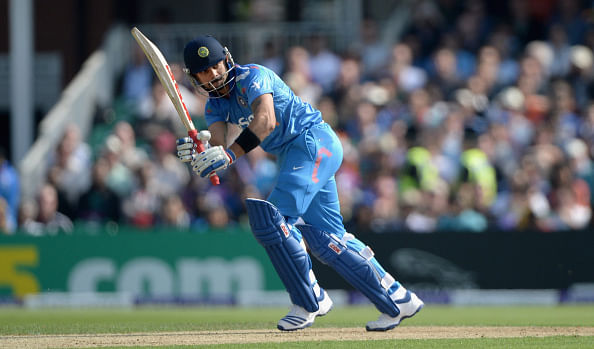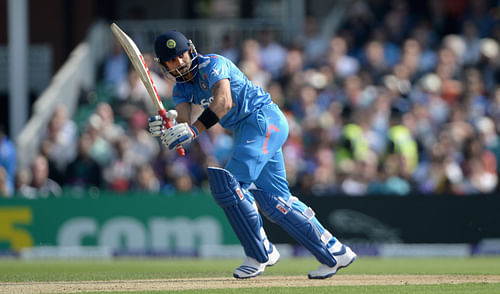
Looking at India's list of probables for the World Cup - Can they make it two in two?

So the 30-man Indian preliminary squad for the World Cup is out with the pretty much expected omission of notable stars of the 2011 World Cup. Zaheer Khan, Gautam Gambhir, Virender Sehwag, Yuvraj Singh and Harbhajan Singh have all been excluded from the list of probables, with BCCI secretary Sanjay Patel saying: "The thought process was to give preference to performers. The youngsters have been doing very well at the domestic level so they could not be ignored."
So, with that out of the way, the most important question that needs answering and the one that pretty much every Indian will want an answer for is whether this group of probables will have what it takes to make it two in a row for the team when all nations square up in Australia and New Zealand for the World Cup next year.
First impressions
At first glance, something that can be said about the current Indian team is that if the World Cup was held in the subcontinent, then India would have been the runaway favourites for the title because they have all the ingredients to nail other sides by batting them out of the match.
It is clear that the team is selected keeping the strengths of the current side in mind and the final eleven is expected to rely heavily on the batsmen. But with the tournament being held in Australia, there are a few doubts that do creep in.
Batting
The current batting lineup boasts of players who have a pretty impressive record in subcontinent conditions, but when they go abroad, their records do take a beating and they’re hardly able to impose themselves on the opposition and end up going into their shell while batting. That’s something that was very clear when the team was in New Zealand and South Africa.
The batsmen weren’t comfortable at the crease and just couldn’t cope with the movement and bounce most of the time. Other than the ODIs in England when the batsmen did get a handful of runs, there haven’t been many instances when the Indian batting order have imposed themselves overseas. Be it Rohit Sharma or Shikhar Dhawan or Suresh Raina for that matter, none of them have had a fruitful run in bouncy conditions in the recent past and have looked completely at sea most of the time.
Whenever we talk about Indian teams that have had success overseas in the past then one thing that has stood out was that the combination of batsman and bowlers, working well in tandem. Batsmen were technically correct and had a decent run (although not so spectacular) in those conditions before.
Be it the 2003 World Cup team which reached the final – one which had Sachin Tendulkar, Sourav Ganguly and Rahul Dravid – as the core of the batting lineup, or the Commonwealth Bank tri-series triumph in Australia which had Gautam Gambhir, Tendulkar and MS Dhoni as the main protagonists. Compare that to the current side and somehow the batting doesn’t inspire the same confidence on Australian pitches as it would in the Indian subcontinent.
Apart from Kohli and Dhoni to a certain extent, the other players in the lineup have all been caught out badly with the bouncing delivery.
Bowling
Moving on to the bowling department. Although, it is filled with some potentially good bowlers, it includes most of the bunch that failed to make a sizeable impact on the opposition when they played in similar conditions in England, New Zealand and South Africa. Bhuvneshwar Kumar and Mohammed Shami are the bowlers who are expected to lead the attack in Australia with Varun Aaron, Umesh Yadav and most probably Ishant Sharma fighting it out for the remaining position.
The problem lies in the fact that the current bowling attack doesn’t seem incisive enough to make inroads into the team and on some occasions cover up the shortcomings of the batting line-up (which are expected to unravel when they play on responsive pitches). With the spin department most probably comprising of R Ashwin and Ravindra Jadeja, it does appear that they’ll play more of a holding role than an aggressive one.
Advantage of touring Australia
In all, the team that will be fielded would be a team that would rely heavily on its batting lineup to cover up for any shortcomings that are expected to be there in the inexperienced bowling lineup that India will field. The selection committee has weighed the pros and cons and decided that batting is the strength of the team and if there is anything that is going to give them the crown then it will the batting muscle that is present in plenty.
One thing though that they will try to count on is the fact that India will be touring Australia for a while before the World Cup starts and it could act as a perfect training ground for the batsmen to acclimatize and get used to the bouncy conditions and learn how they’re going to play in those conditions. They’ve packed a team with batsmen who often struggle on fast pitches and will be trying to use them in the same way as they do in the subcontinent, i.e by batting the opposition out of the match.
Will it work or not is something that one must wait and watch as Australian tracks are not going to be as flat as the ones in India where sometimes even a 300+ score seems to be easily in grasp, unlike the Australian pitches where sometimes a score of even 220 takes some getting. So most of the times, the batsmen will be trying to score 20-30 runs more than the par score to keep the bowlers in business and doing that match after match could prove to be a tough ask.
Keeping this in mind and also considering how other teams are faring right now, India could rank as the third most potent side in the World Cup after Australia (with a good mix of fast bowlers and batsmen) and South Africa (quite similar to Australia, but lack a bit in the batting department).
Final verdict
It is tough to predict how India’s World Cup campaign will go about this time around. Though a few but not all of the indications of how they will fare will be on display in the current series against Australia. On first look, the current Indian squad does have the potential to lift the World Cup, but there are also chances of them performing badly and getting eliminated early in the tournament.
The format of the World Cup does favour India. If they are able to get themselves into the World Cup early on (which they will be allowed to because of the presence of some comparatively weak opposition), then they can work on that momentum and run through the knockouts to take the championship. One team that can spoil India’s party is Australia, so they’ll have to plan accordingly.
Considering all factors; the schedule, the team lineup and the opposition lineups, it does look like the batsmen could take India to a second consecutive crown at the grandest stage in cricket